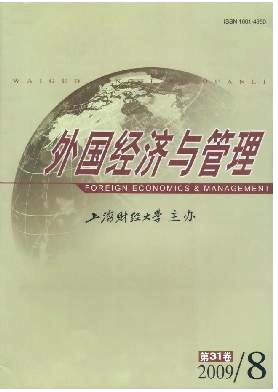品牌主题语回想研究探析
外国经济与管理 2009 年 第 31 卷第 08 期, 页码: - 45
摘要
参考文献
摘要
近40年来,围绕回想这个品牌主题语效力的测量指标,西方学者进行了大量的研究,取得了丰硕的成果,并且把品牌主题语回想拓展成为一个重要的研究领域。本文总结了品牌主题语回想的概念、作用和测量方法,考察了品牌主题外部因素和本身特性对回想的影响,运用学习理论分析了品牌主题语回想的基本规律,指出了现有研究的不足,并对未来研究进行了展望。
[1]Katz,M,and Rose,J.Is your sloganidentifiable[J]?Journal of Advertising Research,1969,9(1):21-43.
[2]Reece,B B,Vanden Bergh,B G,and Li,H.What makes a slogan memorable and who remembers it[J].Journal of Current Issuesand Researchin Advertising,1994,16(2):41-57.
[3]Pham,MT,and Johar,G V.Contingent processes of sourceidentification[J].Journal of Consumer Research,1997,24(3):249-265.
[4]Keiser,S K.Awareness of slogans and brands[J].Journal of Advertising Research,1975,15(4):37-43.
[5]Reece,B B.Children’s ability to identity retail stores fromadvertising slogans[J].Advances in Consumer Research,1984,11(1):320-323.
[6]Moore,R L,and Stephens,L F.Some communication and demographic determinants of adolescent consumer learning[J].Journal ofConsumer Research,1975,2(2):80-92.
[7]Dotson,MJ,and Hyatt,E M.Acomparison of parents’and children’s knowledge of brands and advertising slogans in the UnitedStates:I mplications for consumer socialization[J].Journal of Marketing Communications,2000,6(4):219-230.
[8]Ward,S,and Wackman,D.Family and media influences on adolescent consumer learning[J].American Behavioral Scientist,1971,14(3):415-427.
[9]Larson,C M,and Wales,HG.Slogan awarenessinthe Chicago market[J].Journal of Advertising Research,1970,10(6):38-41.
[10]Dahlén,M,and Rosengren,S.Brands affect slogans,or slogans affect brands?Competitive interference,brand equity and thebrand-slogan link[J].Journal of Brand Management,2005,12(3):151-164.
[11]Harris,RJ,Trusty,ML,Bechtold,J I,and Wasinger,L.Memory for i mplied versus directly stated advertising clai ms[J].Psy-chology&Marketing,1989,6(2):87-96.
[12]Lee,M Y P,and So,D WC.Corporate-slogan of corporations operatingin greater China[J].Corporate Communications:An In-ternational Journal,2007,12(1):58-74.
[13]Chomsky,N.Syntactic structures[M].The Hague:Mouton,1957.
[14]Bradley,S D,and Meeds,R.Surface-structure transformations and advertising slogans:The case for moderate syntactic complexity[J].Psychology&Marketing,2002,19(7/8):595-619.
[15]Tavassoli,N T,and Han,J K.Scripted thought:Processing Korean Hancha and Hangul in a multi media context[J].Journal ofConsumer Research,2001,28(3):482-493.
[17]Jun,J W,and Lee,HS.Cultural differences in brand designs and tagline appeals[J].International Marketing Review,2007,24(4):474-491.
[18]Moschis,G P,and Churchill,Jr G A.Consumer socialization:Atheoretical and empirical analysis[J].Journal of Marketing Re-search,1978,15(4):599-609.
[19]Anderson,J R,and Reder,L M.An elaborative processing explanation of depth of processing[A].in Cermak,L S,and Craik,FI M(Eds.).Levels of processingin human memory[C].Hillsdale,NJ:Lawrence Erlbaum Associates,1979:385-403.
[20]Rosengren,S,and Dahlén,M.Brand-slogan matchingin a cluttered environment[J].Journal of Marketing Communications,2006,12(4):263-279.
[2]Reece,B B,Vanden Bergh,B G,and Li,H.What makes a slogan memorable and who remembers it[J].Journal of Current Issuesand Researchin Advertising,1994,16(2):41-57.
[3]Pham,MT,and Johar,G V.Contingent processes of sourceidentification[J].Journal of Consumer Research,1997,24(3):249-265.
[4]Keiser,S K.Awareness of slogans and brands[J].Journal of Advertising Research,1975,15(4):37-43.
[5]Reece,B B.Children’s ability to identity retail stores fromadvertising slogans[J].Advances in Consumer Research,1984,11(1):320-323.
[6]Moore,R L,and Stephens,L F.Some communication and demographic determinants of adolescent consumer learning[J].Journal ofConsumer Research,1975,2(2):80-92.
[7]Dotson,MJ,and Hyatt,E M.Acomparison of parents’and children’s knowledge of brands and advertising slogans in the UnitedStates:I mplications for consumer socialization[J].Journal of Marketing Communications,2000,6(4):219-230.
[8]Ward,S,and Wackman,D.Family and media influences on adolescent consumer learning[J].American Behavioral Scientist,1971,14(3):415-427.
[9]Larson,C M,and Wales,HG.Slogan awarenessinthe Chicago market[J].Journal of Advertising Research,1970,10(6):38-41.
[10]Dahlén,M,and Rosengren,S.Brands affect slogans,or slogans affect brands?Competitive interference,brand equity and thebrand-slogan link[J].Journal of Brand Management,2005,12(3):151-164.
[11]Harris,RJ,Trusty,ML,Bechtold,J I,and Wasinger,L.Memory for i mplied versus directly stated advertising clai ms[J].Psy-chology&Marketing,1989,6(2):87-96.
[12]Lee,M Y P,and So,D WC.Corporate-slogan of corporations operatingin greater China[J].Corporate Communications:An In-ternational Journal,2007,12(1):58-74.
[13]Chomsky,N.Syntactic structures[M].The Hague:Mouton,1957.
[14]Bradley,S D,and Meeds,R.Surface-structure transformations and advertising slogans:The case for moderate syntactic complexity[J].Psychology&Marketing,2002,19(7/8):595-619.
[15]Tavassoli,N T,and Han,J K.Scripted thought:Processing Korean Hancha and Hangul in a multi media context[J].Journal ofConsumer Research,2001,28(3):482-493.
[17]Jun,J W,and Lee,HS.Cultural differences in brand designs and tagline appeals[J].International Marketing Review,2007,24(4):474-491.
[18]Moschis,G P,and Churchill,Jr G A.Consumer socialization:Atheoretical and empirical analysis[J].Journal of Marketing Re-search,1978,15(4):599-609.
[19]Anderson,J R,and Reder,L M.An elaborative processing explanation of depth of processing[A].in Cermak,L S,and Craik,FI M(Eds.).Levels of processingin human memory[C].Hillsdale,NJ:Lawrence Erlbaum Associates,1979:385-403.
[20]Rosengren,S,and Dahlén,M.Brand-slogan matchingin a cluttered environment[J].Journal of Marketing Communications,2006,12(4):263-279.
引用本文
牛永革, 赵平. 品牌主题语回想研究探析[J]. 外国经济与管理, 2009, 31(8): 0–45.
导出参考文献,格式为:
下一篇:体验价值结构维度理论模型评介





 5006
5006  431
431

